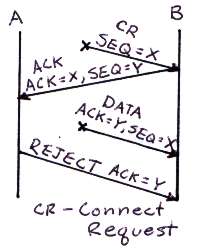- Compute the propagation
delay for this link, assuming that the propagation speed is 2 * 10^8 m/s.
- Suggest a suitable
time-out value for the ARQ scheme to use.
- Why might it still
be possible for the ARQ algorithm to time out and retransmit a frame,
given this time-out value?
- Would sequence
numbers be necessary in this protocol? Why or why not?
- Would a timer be
necessary or advisable in this protocol? Why or why not? If so, would
it be preferable to have the timer at the sender or receiver? Why?
- Describe (in words
or in pseudocode) the operation of a NACK-only receiver that would operate
with this sender. If there are scenarios (no matter how unlikely) that
your receiver would fail to operate reliably, identify these scenarios.
- What would be the
most important advantage of a NACK-based protocol?
- The 4th frame is
lost.
- The 4th, 5th and
6th frames.
 |
(10 points) Examine the figure to the right. Here both a CONNECTION REQUEST and an acknowledgment to a CONNECTION ACCEPTED which where floating around in the network arrive at host B. Both arrive before host A gets a chance to reject the connection. This is unfortunate because host B has accepted the stale DATA packet with sequence number X causing unknown havoc. However the TCP handshake protocol does not have this problem and there is something wrong with this picture. How does TCP deal with this double duplicate delayed packet delivery scenario and what is wrong with this picture? |